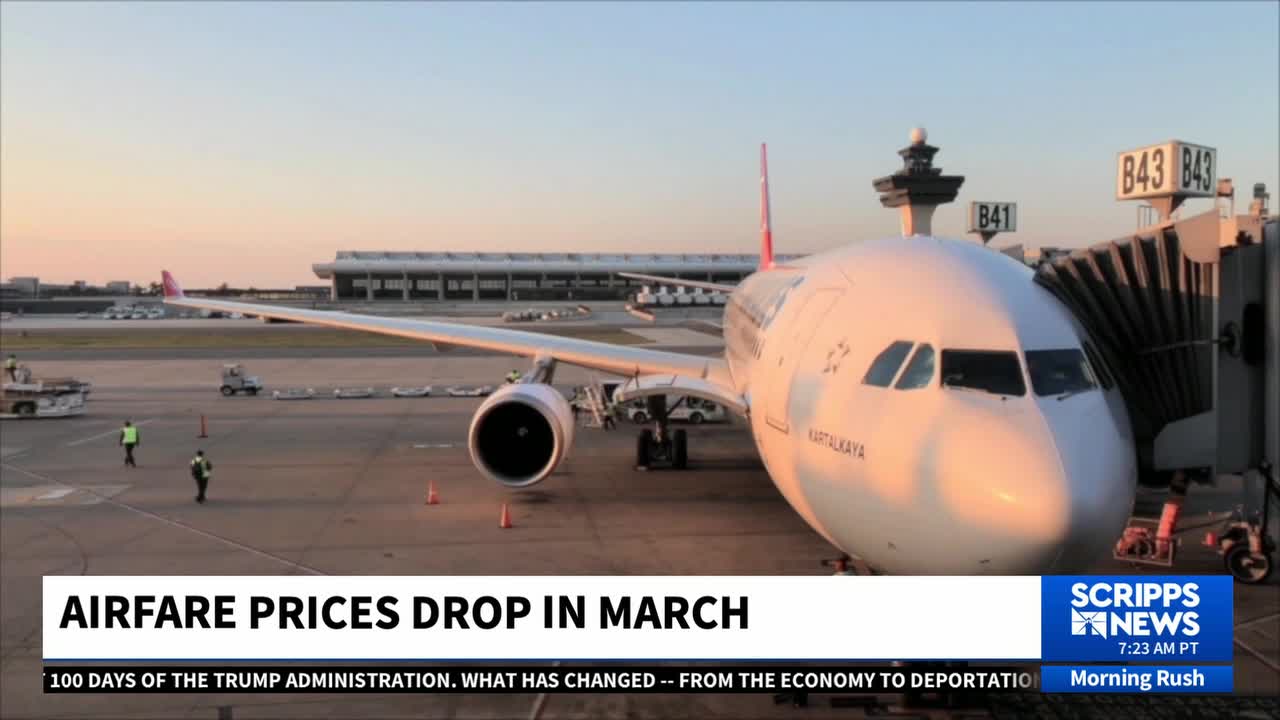
Airfare prices decline ahead of summer travel season
Major carriers, including Southwest Airlines, United Airlines, and Delta Air Lines, are also cutting back on flight schedules.
Scripps News
Another potentially encouraging inflation report this week could be at least partly traced to a surprising source: President Donald Trump’s sweeping tariffs.
The import fees are expected to start driving prices sharply higher in the next month or two as businesses pass most of their added costs to consumers.
But for now, the levies are helping tamp down inflation by raising global recession fears and crimping Americans’ finances and spending, at least for some services, said Ryan Sweet, chief U.S. economist of Oxford Economics.
Few forecasters, of course, believe a temporary inflation drop-off is worth a coming economic downturn.
But the pullback could make it more challenging for Federal Reserve Chair Jerome Powell to explain why officials are still holding off on market-friendly interest rate cuts, especially if job growth starts to weaken as soon as this month.
“If you get a disappointing jobs report and the inflation numbers look good, the market will say, ‘Why aren’t you cutting?’” Sweet said.
Trump on Thursday again lashed out at Powell, calling the Fed chair a fool who “doesn’t have a clue” in a social media post. The Fed on Wednesday opted to hold interest rates steady and Powell reiterated Trump’s calls for lower rates don’t impact Fed decisions.
Is inflation really going down?
Some of the inflation-softening effects of Trump’s tariff announcements are already visible. In March, overall inflation dipped to a five-month low of 2.4% and a core measure that strips out volatile food and energy items fell to 2.8%, lowest since March 2021, according to the consumer price index. On a monthly basis, inflation was virtually flat.
The trade war wasn’t necessarily the main reason for the benign readings. Used car prices tumbled and rent increased an average 4% annually, the smallest rise since January 2022. And forecasters expected inflation to slow early this year because prices surged in early 2024, creating more favorable comparisons to the year-ago figures.
But the inflation-dampening effects of tariffs could persist and even widen in the April CPI report, set to be released Tuesday, and the May numbers too, Sweet said.
What are the expectations for CPI in April?
Inflation overall likely held steady at 2.4% last month, according to economists surveyed by Bloomberg, though Barclays estimates it edged down to 2.3%, lowest since February 2021 and modestly above the Fed’s 2% goal. The core measure is projected to have stayed at 2.8%.
Other forces besides tariffs also may have contributed to mild inflation last month. An easing bird flu crisis already has dramatically lowered wholesale egg prices and could have filtered into retail prices, which have been soaring, last month, Oxford said.
Here’s why tariffs are helping curb inflation:
Oil and gasoline prices
The levies have substantially slowed trade and stoked global recession concerns, helping push down U.S. crude oil prices to about $60 a barrel from $80 in January and $71 just before Trump’s announcement of sweeping reciprocal tariffs on April 2.
That’s not the only reason for the price decline. OPEC agreed to increase oil production starting in April, noted Sweet and Barclays economist Pooja Sriram.
Gasoline prices, in turn, fell 6.3% in March and Barclays estimates they dipped another 0.4% last month.
Airline fares and hotel rates
The trade war has discouraged foreign travel to the U.S., especially from Canada, economist Stephen Brown of Capital Economics wrote in a note to clients. U.S. household spending generally has held up despite plunging consumer confidence but Americans are starting to pare back outlays for big-ticket items such as vacations, Sweet said.
Also spurring airlines to cut fares: Falling oil prices have lowered jet fuel costs, he said.
Airline fares fell 4% in February and 5.3% in March. Barclays estimates they slid another 2% in April.
Such costs usually rise in spring ahead of the summer travel season, Sriram said. The drop, she said, is likely “tied to sentiment.”
Financial services fees
When the stock market vaulted to an all-time high in February, the fees charged by investment companies helped fuel inflation because they’re based on a percentage of clients’ total holdings, which had swollen.
But despite a recent rally, a tariff-driven stock sell-off has left the S&P 500 index about 8% off its February peak. And the market remains volatile.
Such financial service fees don’t carry significant weight in the CPI report but they do in another inflation reading – called the personal consumption expenditures (PCE) price index – that the Fed follows more closely.
All told, Sweet estimates such effects could constrain annual inflation by about three-tenths of a percentage point over the next month or so.
But he expects tariffs to start pushing up prices for used cars and other items as early as June while Sriram figures the acceleration will begin in July. Both economists expect core inflation to rise to about 4% by the end of the year.
“The inflation numbers are going to look good in April and possibly May,” Sweet said. “But the boost to inflation from tariffs is coming.”